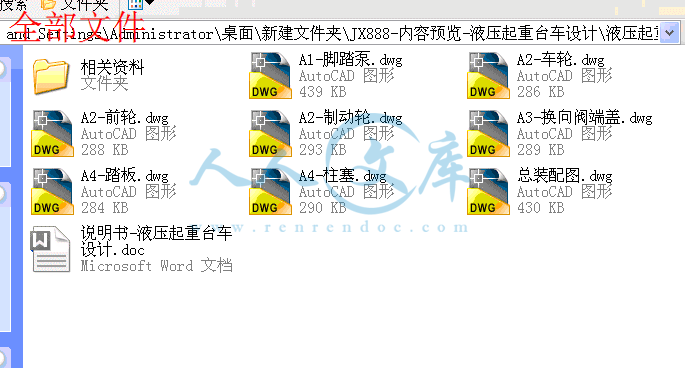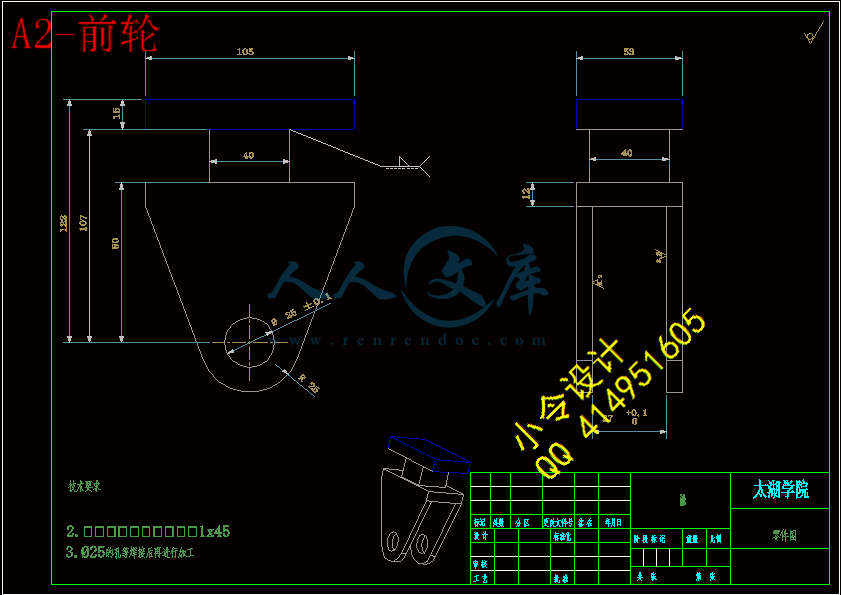摘 要
毕业设计我的课题是液压起重台车设计。
设计该液压起重台车主要是用于及时更换机床工具,其特征是用车轮行驶,可制动,用脚进行液压提升和下降,承重500公斤,工作台高度可从660mm,调节到960mm。在设计过程中,对主要受力零件进行了强度、稳定性的分析及计算,使设计零件达到安全指标。并且对其中受力最大的零件——柱塞杆进行了有限元分析。该液压起重台车比起现代化的电动起重车显得极为落后,但本设计结构设计简单、合理,而且成本低廉、操作方便,是非常实用的一部运输工具。论文最后还对起重台车的工作原理进行了介绍,并附有使用和维护的说明。
关键词: 液压;强度计算;工作原理;液压系统
Abstract
My topic of The graduation project is the hydraulic pressure and hydraulic system design.
Designs this hydraulic pressure to get up the heavy trolley mainly issues in promptly to replace the engine bed tool, its characteristic is with the wheel travel, may apply the brake, carries on the hydraulic pressure promotion and the drop with the foot, the load-bearing 500kilograms, the work table highly may from 660mm, adjust 960mm. In the design process, has carried on the intensity to the main stress components, the stable analysis and the computation, enables the design components to achieve the security target. And has carried on the finite element analysis to stress biggest components - plunger rod. This hydraulic pressure gets up the heavy trolley to compare modernized the electrically operated derrick car to appear extremely falls behind, but this design structural design simple, reasonable,moreover the cost is inexpensive, the ease of operation, is extremely practical transport means. The paper finally also to got up the heavy trolley principle of work to carry on the introduction, and attached the explanation which used and maintains.
Key words: Hydraulic pressure;Strength calculation;Principle of work; The hydraulic system
目录
摘 要III
AbstractIV
目录V
第一章 绪论1
1.1国际起重市场分析1
1.2起重机发展趋势1
1.2.1发展超大型起重机1
1.2.2迷你起重机大量涌现2
1.2.3伸缩臂结构不断改变3
1.3 液压系统的类型3
1.3.1 液压系统的回路3
第二章 原始数据及设计要求5
2.1设计原始参数5
2.2设计要求5
第三章 强度及稳定性计算7
3.1液压缸的设计7
3.1.1确定液压缸的工作压力7
3.1.2确定液压缸内径7
3.1.3液压缸的壁厚和外径的计算7
3.1.4缸筒变形的计算8
3.2柱塞杆的强度计算8
3.3塞杆稳定性计算10
3.3.1无偏心载荷时的纵向弯曲极限力10
3.3.2承受偏心载荷时的纵向弯曲极限力11
3.3.3 活塞杆最大容许行程的计算12
3.4脚踏泵的一些计算13
3.4.1脚踏泵油箱所有油量的计算13
3.4.2柱塞运动到最高处时,所需踏的次数13
3.4.3小柱塞油泵所能产生的压力P214
3.4.4复位弹簧的一些参数计算15
第四章 工作原理介绍18
4.1液压工作原理图如下:18
4.2 液压传动的工作原理19
4.3高压油管的选择19
4.4低压油管的选择19
4.5低压油管接头的选择19
4.6油箱的选择20
第五章 液压系统的使用和维护22
5.1液压油的选择及使用22
5.2维护注意事项24
5.3液压系统的发热验算24
第六章 UG有限元分析25
6.1 目的25
6.2 三维实体造型25
6.3 有限元分析27
第七章 结论32
致谢33
参考文献34
第一章 绪论
1.1国际起重市场分析
近20年世界工程起重机行业发生了很大变化。打破了原有产品与市场格局,在经济发展及市场激烈竞争冲击下,导致世界市场进一步趋向一体化。目前世界工程起重机年销售额已达75亿美元左右。主要生产国为美国、日本、德国、法国、意大利等,世界顶级公司有10多家,世界市场主要集中在北美、日本和欧洲。
美国既是生产工程起重机的主要国家,又是最大的世界市场之一。由于日本、德国起重机工业的迅速发展及RT和AT产品的兴起,美国厂商曾在60~70年代世界市场中占有的主导地位受到削弱,从而形成美国、日本和德国三足鼎立之势。近几年美国经济回升,市场活跃,外国厂商纷纷参与竞争。美国制造商的实力也有所增强,特雷克斯起重机公司的崛起即是例证。
近年来,随着工程建设规模的扩大,起重安装工程量越来越大,吊装能力、作业半径和机动性能的更高要求促使起重机发展迅速,具有先进水平的塔式起重机和汽车起重机已成为机械化施工的主力。
相对于其他起重机,液压起重机不仅具有移动方便,操作灵活,易于实现不同位置的吊装等优点,而且对其进行驱动和控制的液压系统易于实现改进设计。随着液压传动技术的不断发展,液压汽车起重机已经成为各起重机生产厂家主要发展对象。
1.2起重机发展趋势
1.2.1发展超大型起重机
由于各重点工程向大型化发展,所需构件和配套设备重量不断增加,对超大型起重设备的需求日趋增长。1992年200t以上伸缩臂式起重机的世界销量为90台,到1997年增至130台。德国厂商在起重机大型化发展进程中处于领先地位。世界市场中150t以上的大吨位起重机多数是由利勃海尔和德马泰克公司提供的。利渤海尔LTM1800型是目前世界最大的AT产品,起重量800t,安装了超起装置后型号变更为LTM11000D型,最大起重量增至1000t。
德马泰克公司1997年推出的AC650型安装了超起装置后,最大起重量可从650t增至800t。AC650是目前世界上起重吨位最大的整装式伸缩臂起重机,行驶状态不需拆下吊臂分别运输。
住友建机、多田野和加藤公司曾于1989年相继推出360t汽车起重机。住友建机在90年代开发出80t~250t共4种AT产品。多田野也在90年代相继推出100t~550t共6种特大型AT产品。加藤公司则研制成NK5000型500t汽车起重机。目前日本生产的特大型起重机仅在国内销售。
液压传动的主要缺点是漏油问题难以避免。为了防止漏油问题,元件的制造精度要求比较高。油液粘度和温度的变化会影响机构的工作性能。液压元件的制造和系统的调试需要较高的技术水平。
从液压传动的优缺点来看,优点大于缺点,根据国际上起重机的发展来看,不论大小吨位都采用液压传动系统。纵观众多用户的反馈意见,液压式汽车起重机深受他们的欢迎和好评。
优点
液压传动的起重机,结构上容易实现标准化,通用化和系列化,便于大批量生产时采用先进的工艺方法和设备。此种起重机作业效率高,辅助时间短,因而提高了起重机总使用期间的利用率,对加速实现四个现代化大有好处。
缺点
液压传动的主要缺点是漏油问题难以避免。为了防止漏油问题,元件的制造精度要求比较高。油液粘度和温度的变化会影响机构的工作性能。液压元件的制造和系统的调试需要较高的技术水平。
从液压传动的优缺点来看,优点大于缺点,根据国际上起重机的发展来看,不论大小吨位都采用液压传动系统。纵观众多用户的反馈意见,液压式汽车起重机深受他们的欢迎和好评。所以液压起重台车决定采用液压传动的形式。
1.2.2迷你起重机大量涌现
起重机向微型化发展,是适应现代建设要求而出现的新趋势。10年前开发的神钢RK70(7t)是世界首台装有下俯式吊臂的“迷你”(Mini) RT产品。目前下俯式吊臂已成为“迷你”起重机的重要标志。这种新概念设计已成功移植到德马泰克AC25(25t)和加藤CR-250(25t)等较大吨位起重机上。
小松公司曾在90年代初、中期相继推出了装有下俯式吊臂的 LW80(8t)和LW100-1(10t)“迷你”RT产品。该公司还曾于1993年和1997年分别推出了另外两种别具特色的LT300型(4.9t)和LT500型(12t)“迷你”RT。据资料介绍,LT300型与LT500型是世界首批装有全自动水平伸缩副臂的轮式起重机。它们将轮式起重机公路行驶能力与专用伸缩臂架技术融为一体,且具有塔机功能,可越过屋顶或其他障碍物靠近作业面,能替代小型自行架设塔机或大型折叠臂式随车起重机。
1.2.3伸缩臂结构不断改变
利渤海尔LTM1090/2(90t)和LTM1160/2型(160t)AT产品,采用了装有“Telematik”单缸自动伸缩系统的卵圆形截面主臂。这种卵圆形截面主臂在减轻结构重量和提高起重性能方面具有良好效果。目前卵圆形吊臂已列入利勃海尔新产品标准部件,装有世界最长的7节84m卵圆形截面主臂的LTM1500型(500t)AT产品,也采用这种单缸伸缩系统。格鲁夫开发的单缸伸缩系统要早于利勃海尔公司,但格鲁夫早期采用的单缸伸缩系统伸缩速度较慢。此外,德马泰克大吨位起重机主臂也采用卵圆形截面。
格鲁夫GMK6250(250t)和GMK5180(180t)两种AT产品,采用了装有双销双锁自动伸缩系统的U形截面主臂,伸臂速度较快(平均9m/s左右)。伸缩系统由电子式起重机操作装置控制,可将主臂自动伸至各种选定臂长。据报道,美国谢迪.格鲁夫工厂将采用德国工厂的主臂制造技术,原有梯形主臂将被淘汰,原因是焊接工艺复杂,制造成本高。
1.3 液压系统的类型
1.3.1 液压系统的回路
液压系统要实现其工作目的必须经过动力源——控制机构——机构三个环节。其中动力源主要是液压泵;传输控制装置主要是一些输油管和各种阀的连接机构;执行机构主要是液压马达和液压缸。这三种机构的不同组合就形成了不同功能的液压回路。
泵—马达回路是起重机液压系统的主要回路,按照泵循环方式的不同有开式回路和闭式回路两种。
开式回路中马达的回油直接通回油箱,工作油在油箱中冷却及沉淀过滤后再由液压泵送入系统循环,这样可以防止元件的磨损。但油箱的体积大,空气和油液的接触机会多,容易渗入。
1.3.2起升液压系统
对起重机来说,起升动作是最频繁的动作。目前最常用的起升液压系统为定量泵、定量或变量马达开式液压系统,然而,现代施工对起升系统提出了新的要求:节能、高效、可靠以及微动性、平稳性好。为了适应这些新的要求,以前的定量泵将逐步被先进可靠的具有负载反馈和压力切断的恒功率变量泵所取代,先前的定量马达或液控变量马达也将被电控变量马达所取代。这种系统将能有效的达到轻载高速、重载低速和节能的效果。
1.3.3 操纵、控制系统
机械式操纵是汽车起重机最简单、最广泛使用的一种操纵方式,液比例操纵系统在我厂也己广泛使用并相当成熟,操作性能得到了很大的提高;然而,最有发展前途的还是电比例操纵系统,借助于计算机技术和可编程技术,汽车起重机将向智能化发展。
除此之外,液压系统在以下几方面也体现出明显的发展趋势:
(1)、采用国际化配套,对系统性要求较高的液压元件如泵、阀、马达等采用国际化配套可提高产品的可靠性,另外,国外使用成熟、量大价廉的元件在国内也广泛使用。
(2)、采用卡套式接头,由于卡套式接头在控制系统污染、防泄露等方面具有很强的优越性,使用卡套式接头能大大减少故障率和早期反馈率。
(3)、在系统中设计速度分档,由于不同施工项目的不同要求,对起重机各动作速度的要求也不一样,速度分档技术也应运而生,设计不同的速度档位,以适用不同工况的要求。
(4)、广泛使用高度集成的、模块化阀组,能简化管路,有效的减少液组,提高效率,节约能量,同时易于维护。
(5)、向计算机技术领域的纵深渗透,汽车起重机将向无线遥控技术、远程诊断服务技术、黑匣子自我保护技术等方向发展,为了实现整机的功能,液压技术将同计算机技术相互渗透,共同发展。
第二章 原始数据及设计要求
2.1设计原始参数
1:承重500kg ,即F=500kg
2:工作行程可从660mm调节到960mm。即300mm
2.2设计要求
方案一:
1:用车轮行驶
2:车轮可制动
3:用脚进行液压提升和下降
方案二:
用车轮行驶,和制动都可以不变,只要把先前的脚踏泵改为电动机形式,来实现液压的上升和下降。不过这种方案的缺点就是要求比较高一般不怎么采用。因为设计时也要考虑到该产品的经济性,广泛性多方面的渠道考虑的。然而改为电动的液压千斤顶工作原理一样。
工作原理及组成部分:
1. 泵体由电动机,油泵,综合阀,换向阀,油箱,车轮,等组成。
2. 泵体部分:有电机直接带动偏心轴旋转,使柱塞沿着大油缸做往返运动,使油分别从 高低压进油阀吸入,后从高低压出油阀压出分别进入综合阀的高压油路和低压油路。
3. 综合阀体:由阀体的安全阀,高压路中的额高压单向阀,低压油路中的低压单向阀,安全阀,减压阀,换向阀组成。
经分析讨论最后决定采用第一种方案。






 川公网安备: 51019002004831号
川公网安备: 51019002004831号